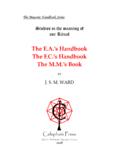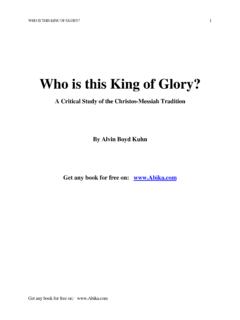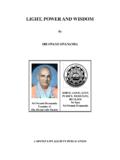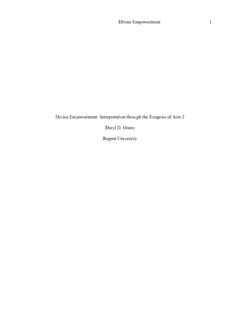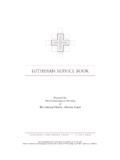Transcription of THE GNOSTIC HANDBOOK - The Masonic Trowel
1 THE GNOSTIC HANDBOOK Institute for GNOSTIC Studies (now Defunct) IntroductionIntroduction11 First PrinciplesFirst Principles22 The Origin of MatterThe Origin of Matter33 Worlds and PlanesWorlds and Planes44 The Conflict between Matter and SpiritThe Conflict between Matter and Spirit55 The GNOSTIC Identity MessageThe GNOSTIC Identity Message66 Dominions and PrincipalitiesDominions and Principalities77 The Nature of ManThe Nature of Man88 The Truth about ImmortalityThe Truth about Immortality99 The Mysteries of RebirthThe Mysteries of Rebirth1010 The Secret WayThe Secret Way1111 The Secret of the Seven ChurchesThe Secret of the Seven Churches1212 Revisioning ScriptureRevisioning Scripture1313A Modern GNOSTIC EcclesiaA Modern GNOSTIC EcclesiaTABLE OF CONTENTSthe GnosticHandbookWe at the GNOSTIC Apostolic Church have felt for many years that there is a great need fora study of the principles on which the GNOSTIC tradition is built. At first we avoided sucha task as our knowledge of the GNOSTIC tradition was still evolving and because anyoutline of religious symbology can come across as dogmatic and doctrinal.
2 However, astime progressed we realised that if we waited until all the facts were in and we worked toavoid misconception, we would end up with the GNOSTIC HANDBOOK never being , we believe that within this HANDBOOK is a comprehensive summary of thebasic principles of the GNOSTIC tradition. We realise that it stands in direct opposition towhat most of the modern Christian Churches teach today. However, we stand-fastbelieving that we have been moved by the spirit of the Pleroma to restore the originalfaith as expounded by the Apostles, and offer this work for your recent times with the advent of fundamentalism of all forms, a clear and preciseexplanation of the ideals of Gnosticism is not only useful, but mandatory. At the onset itshould be made clear that Gnosticism is a personal experience of religion. The termGnosis means "an experience of knowledge" and religion (from the Latin Religio) means"to bind back to the point of origin" and hence Gnosticism is an experience of the realessence of what God is.
3 It does not represent dry dogmatism or a simple recital of facts,but a real and personal experience of God within human experience. It is in this spirit weissue this HANDBOOK . The structure of this HANDBOOK is aimed to facilitate easy access ofinformation on basic religious questions. This is not meant to be an exhaustive theologi-cal exposition but a summary of the teachings which embody the GNOSTIC legacy whichhas been passed onto the GNOSTIC Apostolic Church. The approach we have taken in thishandbook has been a religious one, our primary source of symbolism has come fromwithin the Essene, Valentinian, Zoroastrian and Christian GNOSTIC traditions. Otherinterpretations are certainly possible and for those who wish to get behind the symbols,interpretations and beliefs we suggest you study the various publications and coursesissued by the Institute for GNOSTIC hope you will find the GNOSTIC HANDBOOK edifying as well as enjoyable GNOSTIC HANDBOOK Page The GNOSTIC HANDBOOK Page 55 Algebra, Gnosis and ReligionAlgebra, Gnosis and ReligionAlgebra is a branch of mathematics that uses letters etc to representnumbers and quantities.
4 Algebraic is ultimately from Arabic Al-Jabr reunion of broken Oxford Oxford may be thought that Algebra has little similarity to religion, however, if weconsider it more closely they have much in common. Algebra uses letters torepresent actions and numbers, it is a system of representation and in a sense,symbolism. This is also the case with religion. Religion uses symbols to stand forrealities, it uses images to represent things that cannot be easily imagined orexplained. The problem is that Algebra is an academic form of mathematics and haslittle effect on everyday life while religion controls and influences us more than wewould care to admit. Only be removing religious iconography from the realm of theemotions and appreciating it as a symbol system, as a form of divine algebra can wereally understand its nature. The GNOSTIC HANDBOOK is one application, one represen-tational system for the ancient Gnosis.
5 It can be seen in many forms and using manysymbol systems. Accordingly, it is important to realise the difference between therepresentational letter and the thing that is represented, between the essence and theform. The GNOSTIC Apostolic Church hence differentiates between its philosophicalworks (such as GNOSTIC Theurgy) and its religious works (such as the GnosticHandbook).To give an example, while all GNOSTIC traditions agree on the dualist nature of theuniverse, there are many divergent ways of expressing this dualism. Some Gnosticschools have two Yahwehs, a true and false creator. Others see Yahweh as the fallencreator (Demiurge) and postulate a Lord of wisdom who is the true Creator. Whileall of these representational systems are divergent, their essential message is thesame. In algebraic terms while the letters vary, the numbers they represent areidentical.
6 This should be kept in mind while studying this HANDBOOK , it is one andone only interpretation of the essential GNOSTIC aim of using Algebra according to the Arabs was to have a better understandingThe GNOSTIC HANDBOOK Page The GNOSTIC HANDBOOK Page 66of the real nature of the equation, to find the essential form through the many shardsor forms. This too is the vision of the Gnosis, the Arabic meaning of Algebraic ispregnant with meaning the reunion of broken Sources of our TraditionThe Sources of our TraditionThe GNOSTIC tradition is one that has spanned Millenniums, it represents the height ofthe religious traditions of Humanity. Its primary points of focus are found withinVedic Philosophy, Zoroastrianism, Israelite Mystery traditions and Gnosticism. TheGnostic tradition is not culturally locked within the Israelite- GNOSTIC Christiantradition as many modern exponents seem to profess.
7 It is a Pan- GNOSTIC tradition,which spans many traditions and cultural milieus. The primary assumption of theGnostic tradition is that at some point in the dim reaches of time there was a primaluniversal religion, this religion degenerated as man degenerated and remnants of itare found within the various faiths. These faiths rather than being the primary sourcesof wisdom within themselves are actually remnants of one earlier, and more pristineschool of knowledge. As time progressed the higher kingdoms saw the loss of gnosisand therefore chose to restore the structure of the Mysteries. When Jesus came to theEssenes he purified the structure of the Mystery traditions and re-instated the originalGnostic faith. Hence, the Gnosticism of Jesus is not superior to other Ariosophicfaiths, but a refinement or adaptation of an age-long tradition - together the variousAriosophic traditions offer a system applicable to modern teachings, however, did not remain available forever.
8 As society changed anda new regime came to power the teachings of Jesus were suppressed and replacedwith the political faith of Emperor Constantine, and accordingly the Gnosis wentunderground to ensure its survival. What we have in today's religious movements arenot the original forms of Judaism and Christianity, but apostate faiths masqueradingin their place. The Bible itself has been tampered with to such an extent that only byreturning to fragments of the other Aryan traditions can we restore the primal GNOSTIC Apostolic Church upholds the original inner teachings of Jesus. Theseare a re-instatement of the original and first faith of the Pan-Aryan tribes, remnantsof which can also be found in other Aryan faiths - but are found in a more refinedform in the esoteric traditions of the early GNOSTIC HANDBOOK Page The GNOSTIC HANDBOOK Page 77 But it is perhaps desirable to state unequivocally that the teachings here,however, fragmentary and incomplete belong neither to the Hindu's, theZoroastrian, the Chaldean, nor the Egyptian Religion, nor to Buddhism,Islam, Judaism or Christianity exclusively.
9 The Secret doctrine is theessence of all Secret Doctrine,The Secret Doctrine,Madame the veil of all the hieratic and mystical allegories of ancientdoctrines, behind the darkness and strange ordeals of all initiations,under the deal of all sacred writings, in the ruins of Nineveh or Thebes,on the crumbling stones of old temples and on the blackened visage ofthe Assyrian or Egyptian Sphinx, in the monstrous or marvellouspaintings which interpret to the faithful of India the inspired pages of theVedas, in the cryptic emblems of our old books on alchemy, in theceremonies practised at receptions of all secret societies, there are foundindications of a doctrine which is everywhere the same and everywherecarefully key of all divine obscurities and the absolutequeen of society in those ages when it was reserved exclusively for theeducation of priests and Magic,Transcendental Magic,Eliphas Levi.
10 The GNOSTIC HANDBOOK Page The GNOSTIC HANDBOOK Page 88 Who is the Lord of wisdom ?Who is the Lord of wisdom ?One of the central issues within any religious tradition is who or what is God ? Inmany early Aryan faiths there is clear definition of God though this may be expressedthrough many diverse images and language forms. These definitions while divergentin form, have one thing in common, they all define God without the using descrip-tions in moral or ethical terms. God simply Is. In some sense this is central to theGnostic understanding of God for he/she/it is beyond definition, to define God in anyway, is in some sense, to limit he/she/it. For the Saivite Hindu, for example, thesupreme deity is defined as Shiva with Brahma and Vishnu simply being modes orpersonas.
